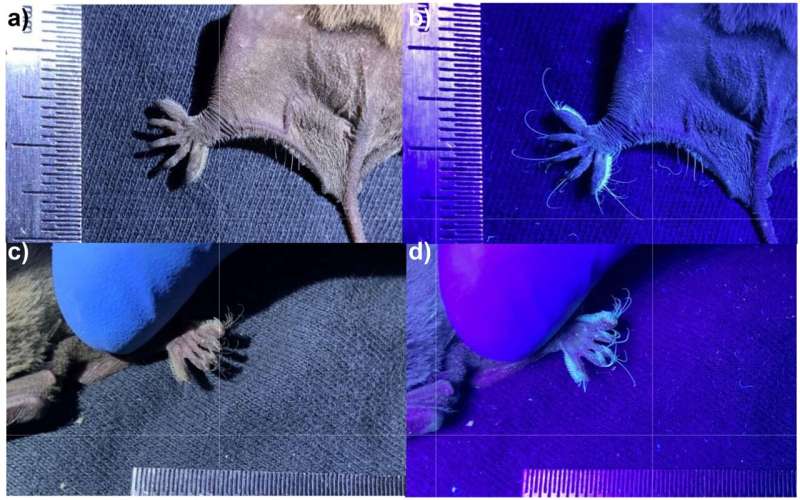September 3, 2024 report
This article has been reviewed according to Science X's editorial process and policies. Editors have highlighted the following attributes while ensuring the content's credibility:
fact-checked
peer-reviewed publication
trusted source
proofread
Mexican bat found to have photoluminescent feet

A small team of zoologists and ecologists with members from Instituto de Ecología and Soluciones Ambientales en Sustentabilidad Ambiental, both in Mexico, and the University of Texas at Austin, has found that a certain species of bat living in Mexico has photoluminescent bristles on their feet.
In their paper published in the journal Mammalian Biology, the group describes how they accidentally discovered the unique feature in the bats and suggest a possible reason for its evolution.
Three years ago, two members of the group were attempting to catch bats from a roost near Mexico City. They were using long strands of fine filament as nets to catch several bats at a time. All of those they caught were carried to a place 30 kilometers to the north, where they were released into another roost.
The aim was to find out if individuals from the two roosts moved back and forth between them. To that end, the researchers dusted the specimens they caught with a powder that could be easily seen using a UV light. That effort failed, the researchers note, but they did find something else—the feet of the bats were lighting up under the lamp, and it was not because of any dust that had been applied.
Prior research has shown that the feet of the Mexican free-tailed bats are unique—they have what are described as spoon-shaped bristles along the outer edges of their toes—making them look like a character drawn by Dr. Seuss. To date, no one has been able to figure out why. Now it appears that those spines are unique in another way—they reflect a blue-green hue under a UV light.
Wanting to make sure the finding was truly unique, the researchers tested and found the same phenomenon in 25 other specimens from both roosts. They also found it on a museum specimen. They have not yet figured out why the spines are photoluminescent, though they suspect the bats can see the glow, but only at dusk or dawn or when basking in the moonlight.
The team plans to conduct experiments to find out if the creatures are using their feet as a way to communicate at night when they are bunched up in colonies that have up to a million bats.
More information: Fernando Gual-Suárez et al, Ultraviolet-induced photoluminescent bristles on the feet of the Mexican free-tailed bat (Tadarida brasiliensis), Mammalian Biology (2024). DOI: 10.1007/s42991-024-00441-3
Journal information: Mammalian Biology
© 2024 Science X Network





















